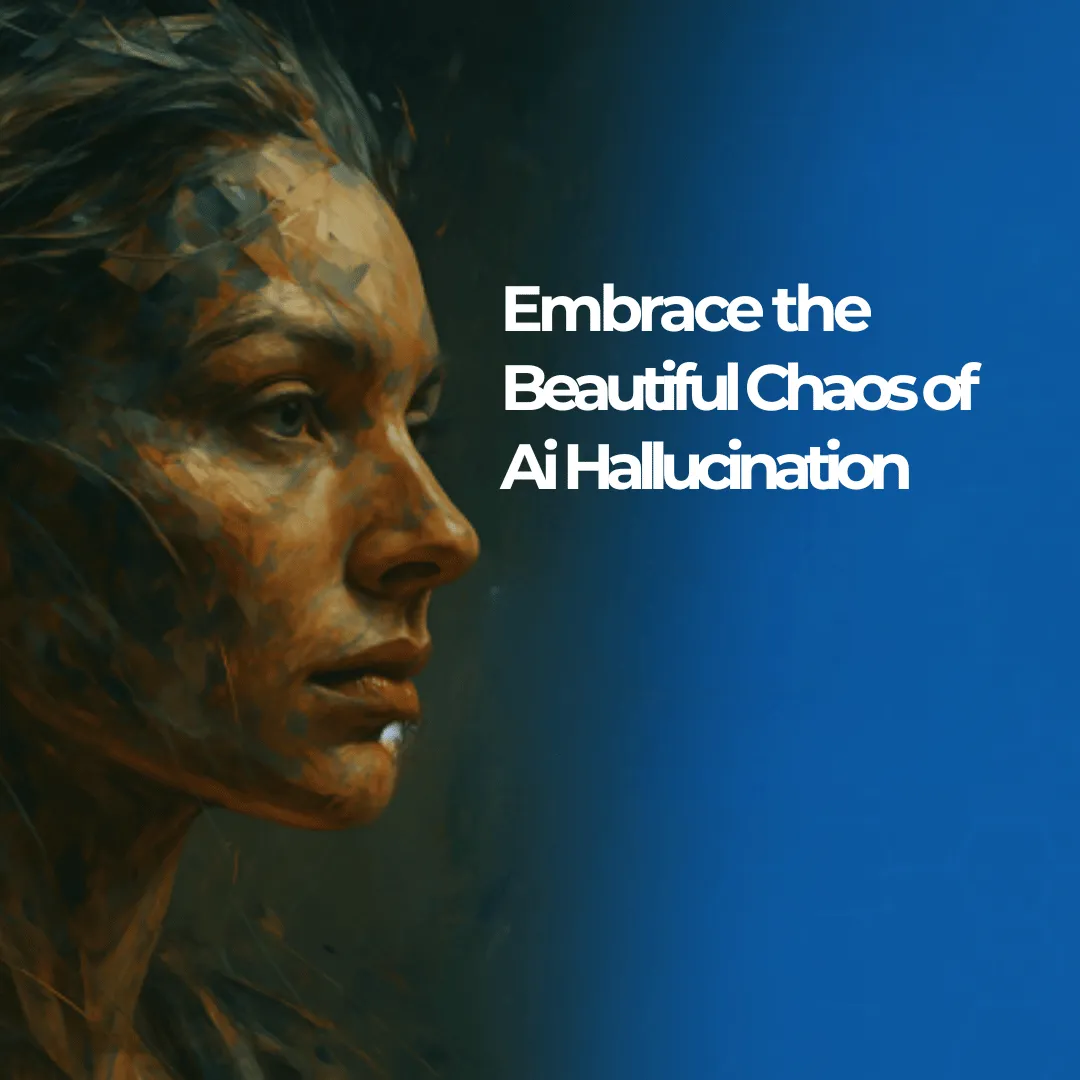
Embracing the Beautiful Chaos of AI Hallucinations
I realized the upside of AI hallucinations the moment I saw one invent a product feature that didn't exist—but customers wished it did. What was framed as an error revealed something deeper: unmet desire.
That's when it clicked. Hallucinations aren't just technical glitches. They're mirrors reflecting customer hopes, assumptions, and emotional drivers.
For marketers, that's not a problem. It's a creative edge.
Reframing the "Problem" of AI Hallucinations
While the tech industry races to eliminate AI hallucinations, treating them as bugs to be squashed, I've discovered something counterintuitive: these so-called errors can be your most powerful creative tool.
The industry's obsession with accuracy misses a fundamental truth about human psychology. People don't just want information. They want meaning, emotion, and imagination.
Hallucinations, when handled responsibly, tap into those desires. They reveal assumptions and possibilities that aren't always obvious in the data.
Consider what happened with one of our family law clients. Their AI assistant accidentally offered a fictional "Parenting Plan Review" service. Complete fabrication.
But here's what stopped us in our tracks: users responded positively, assuming it was real.
That accidental suggestion unlocked something profound. It told us people weren't just looking for legal help—they were looking for reassurance.
We built the real-world equivalent, positioned it around peace of mind, and watched it outperform several existing services. What started as a hallucination became one of their highest-converting lead generators.
This isn't an isolated incident. Heinz Ketchup brilliantly turned AI hallucinations into a marketing advantage with their "A.I. Ketchup" campaign. When they fed DALL-E non-branded prompts like "ketchup bottle stained glass," the AI naturally generated Heinz-like imagery, reinforcing their brand dominance in the cultural consciousness. (https://lbbonline.com/news/how-rethink-proved-even-ai-knows-it-has-to-be-heinz)
The Three Categories of Valuable Hallucinations
Through our work with professional service firms, I've identified three types of AI hallucinations that consistently deliver marketing gold:
1. Invented Features
When AI suggests services or features that don't exist but resonate with users, it's revealing unmet market needs. These hallucinations often reflect real customer desires that your business could fulfill.
A niche financial planning firm we work with discovered this firsthand. The AI hallucinated a service called a "Retirement Blueprint Audit"—something they didn't offer. But the phrasing struck a chord.
It sounded structured, strategic, and far more compelling than "financial review." We built a real-world version, repositioned it as a value-led entry point for new clients, and watched it transform their lead quality.
That single hallucinated phrase helped them stand out in a saturated market where everyone else sounded the same.
2. Emotional Overstatements
Sometimes AI makes claims that aren't factually accurate but strike an emotional nerve. These reveal what your audience wants to believe, which can be ethically reframed into stronger messaging.
When properly filtered, these emotional insights help you speak to deeper motivations that your competitors miss.
3. Simplifying Metaphors
AI often generates fictional scenarios or metaphors that simplify complex ideas. These can lead to fresh ways of explaining your value that cut through noise and confusion.
Ad agency Pereira O'Dell recognized this potential with their "Insights Machine" platform, which creates AI personas that don't always provide factually accurate content but challenge marketers to think differently. As founder PJ Pereira noted, "hallucinations are important to this process... the fact that it's unpredictable adds another layer that gets us thinking... that's where the inspiration comes from." (https://www.thedrum.com/news/2023/11/17/ad-agencies-embrace-ai-hallucination-with-the-insights-machine)
The Ethics of Creative Hallucinations
Let me be clear: I'm not advocating for misleading customers or publishing inaccurate information. The distinction between harmful inaccuracies and valuable creative insights is crucial.
It comes down to intent, context, and consequence.
If the AI generates something that poses a risk of misleading users—especially around pricing, guarantees, or regulated advice—it's a red flag. That's a harmful inaccuracy.
But when AI offers something fictional that clearly reflects customer aspiration or unmet need, that's a signal worth exploring.
The line is simple: if a hallucination can be reframed into an insight without breaching trust, it's usable. If it risks misrepresentation, it gets filtered out immediately.
We learned this lesson the hard way. Early on, we tested a hallucinated message for a legal client that suggested their service could "guarantee custody outcomes." It wasn't malicious, just an overreach in language.
But it immediately raised red flags with the client's compliance team, and rightly so. It was a wake-up call: even well-meaning creative risks can undermine trust if they cross ethical or legal lines.
Since then, we've built stricter filters into our workflow. Nothing moves forward without a review for factual accuracy, regulatory boundaries, and tone.
The lesson was clear: creativity is powerful, but only when it's grounded.
Implementing a Hallucination-to-Innovation Pipeline
For professional service firms with strict compliance requirements, the key is treating hallucinations as internal idea starters—not public-facing content.
Here's the workflow we've developed at Digital Suite:
1. Creative Divergence Sessions
We actively prompt AI to generate wild, sometimes impossible ideas. The goal isn't accuracy but volume and variety of creative concepts.
Rather than waiting for inspiration or sticking to known angles, we deliberately seek out AI's unexpected associations.
2. Human Filtering
Every creative insight goes through a human filter where we assess compliance, factuality, and tone. We treat AI like a junior strategist with range—it can generate raw ideas at scale, but it doesn't make the final call.
A strategist reviews the output for relevance, emotional insight, and alignment with client goals.
3. Compliance and Messaging Checks
Promising concepts go through additional review, especially in regulated industries like law and finance. We never let AI speak outside its lane.
It can surface emotional truths or reframe how we present value—but the final message is always grounded in what's real, ethical, and legally sound.
4. Real-World Implementation
If the idea points to something valuable, we shape it into a legitimate offer or message that stands on solid ground. The goal is to protect the integrity of the message without dulling the edge of the idea.
This discipline is what makes the approach work, especially for our clients in professional services who can't afford to compromise trust.
Overcoming Client Resistance
When I first mention leveraging AI hallucinations creatively, I often encounter resistance—especially from clients in industries where accuracy and trust are non-negotiable.
The word "hallucination" immediately raises red flags. So I don't lead with it.
I frame it as a creative discovery tool, like early-stage R&D for messaging and offer development. I show real examples where a so-called AI error revealed a powerful market insight, then walk them through how we filtered, reframed, and tested it safely.
Once clients see that the process is controlled, ethical, and built for insight—not deception—they get it.
The key is showing that we're not relying on the AI for truth. We're using it to find opportunities hiding in plain sight.
This approach has transformed our creative process, making it faster, more expansive, and far less limited by the obvious. It's like having a brainstorming partner that never runs out of energy—but with zero attachment to what's been done before.
The result? More differentiated positioning, more unexpected offers, and more emotionally resonant messaging for our clients.
The Future of Creative AI Hallucinations
As AI models continue to advance, I don't see the value of hallucinations diminishing. Quite the opposite.
As models become more accurate, hallucinations won't disappear—they'll become rarer, more intentional, and more valuable. Accuracy is useful for execution, but creativity lives in divergence.
In the future, we'll see marketers deliberately prompt for creative deviation—hallucinations won't be bugs, they'll be features we tap into by design.
Think of it like switching between "precision mode" and "imagination mode." The smarter the models get, the more control we'll have over when and how we provoke those off-script ideas.
Studies already show that AI hallucinations represent a tension between novelty and usefulness—a focus on novelty in machine creativity can lead to original but sometimes inaccurate responses, whereas a focus on usefulness may result in memorized content lacking originality. This mirrors the human creative process itself. (https://en.wikipedia.org/wiki/Hallucination_(artificial_intelligence))
This tension isn't something to eliminate—it's something to harness.
Reimagining AI's Creative Potential
In trying to scrub AI of all unpredictability, we risk stripping out the very thing that makes it creatively useful. Precision has its place—but so does provocation.
The future isn't about eliminating hallucinations. It's about learning how to harness them.
For professional service firms looking to stand out in crowded markets, this approach offers a powerful advantage. While competitors focus on saying the same things more efficiently, you can discover entirely new ways to communicate your value.
At Digital Suite, our mission has always been to empower purpose-driven professionals with intelligent, ethical, and scalable digital tools. Our approach to AI hallucinations embodies this philosophy.
We don't just chase accuracy. We pursue meaningful insights that help our clients connect more deeply with their audiences.
Because in the end, the most powerful marketing doesn't just inform. It resonates. It speaks to hopes and aspirations that customers themselves might not fully articulate.
And sometimes, it takes a "hallucination" to reveal those deeper truths.

